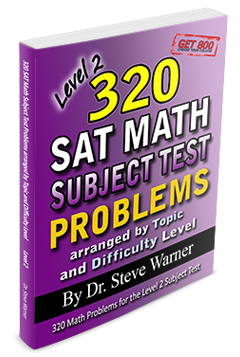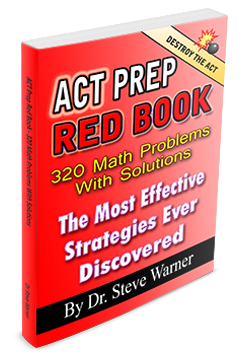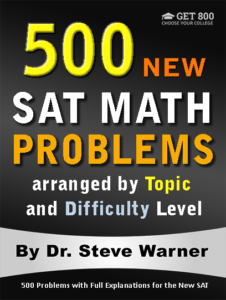
500 New SAT Math Problems
Just 19.99 on Amazon
Hi everyone! The latest edition of 500 New SAT Math Problems is now available in paperback from Amazon. This edition just has been modified from the previous edition to account for the changes on the Digital SAT.
The paperback is now on sale on Amazon for only $19.99. Note that once the sale ends (by the end of today), the price of this book will go up to $42.99.
The promotion has ended. Thanks to everyone who participated. The book is now available at its regular price here: 500 New SAT Math Problems
If you have any questions, feel free to contact me at steve@SATPrepGet800.com
Thank you all for your continued support!
A Trick For Free Two Day Shipping
I would like to finish this post with a little trick you can use to get free 2 day shipping on any of the books you decide to purchase without making any additional purchases. If you have never used Amazon Prime you can sign up for a free month using the following link.
Sign Up For Amazon Prime For Free
If you have already had a free trial of Amazon Prime you can simply open up a new Amazon account to get a new free trial. It just takes a few minutes! You will need to use a different email address than the one you usually use.
This next part is very important! After you finish your transaction, go to your Account, select “Manage my prime membership,” and turn off the recurring billing. This way in a month’s time Amazon will not start charging you for the service.
After shutting off the recurring billing you will still continue to receive the benefit of free 2 day shipping for one month. This means that as long as you use this new Amazon account for your purchases you can do all of your shopping on Amazon for the next month without having to worry about placing minimum orders to get free shipping.
Just be aware that certain products from outside sellers do not always qualify for free shipping, so please always check over your bill carefully before you check out.
Well I hope you decide to take advantage of this very special offer, or at the very least I hope you will benefit from my Amazon “free 2 day shipping trick.” Here is the link one more time:
Sign Up For Amazon Prime For Free
If you think your friends might be interested in this special offer, please share it with them on Facebook:
Thank you all for your continued support!
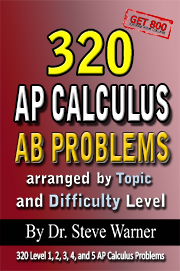 320 AP Calculus AB Problems
320 AP Calculus AB Problems

Today I would like to announce my new AP Calculus prep book for the AB exam: 320 AP Calculus AB Problems arranged by Topic and Difficulty Level
This book will be released on Amazon within the next few weeks at a promotional price of about $5.40.
This sale may last for only a few hours, and once the sale ends the price will go up to $34.99. Amazon will automatically raise the price once a predetermined number of copies has been sold. If you want to take advantage of the sale price I strongly recommend that you get on the email notification list.
To be added to the notification list, simply send an email to steve@SATPrepGet800.com with “Notify me” written in the subject line.
In the meantime, you can take a look at my product page to see all of the other books from the Get 800 collection: Get 800 Product Page
If you think your friends might be interested in being notified of this special offer, please share it with them on Facebook:
Thank you all for your continued support!
 Learning SAT Vocabulary
Learning SAT Vocabulary

by Kazim Mirza
The foundation of your vocabulary learning should begin by internalizing Latin and Greek words that make up many of our English vocabulary words. We urge you not to simply learn by rote memorization. While there are some benefits to rote memorization, we would like you to make multiple connections to these affixes. Different methods of learning these words will reinforce multiple connections, making retrieval of these words quicker and more permanent. Any time you read or hear a new word, analyze the word, then ask yourself what is the origin, and does it have a positive or negative tone? Is this word similar to a word you know? Pick up a dictionary and look at the words surrounding the word you just looked up. The more you challenge yourself, and the more you make the connection, the greater the payoff.
Creating Connections
The best way to create multiple connections is to integrate studying these Latin and Greek words into the rest of your life. When you see a drink, you might remember the word bibere. At this point vocalize the word, and try to recreate a memory. Create a funny sentence, where you are mixing Latin or Greek words with English. This will create familiarity, which in turn will lead to permanent learning. We have made a Flashcard game available for you below to help you learn and practice. Remember to always make connections to things you already know, and be proactive in building your understanding – this is the best way to learn and retain new vocabulary, and this will reflect on your score on Test Day!
Try a small sample of the SAT Vocabulary Game below. See if you know the meaning of each Latin Suffix. Then, click the flashcard to flip the card over!
Click here to play the FULL version of our SAT Vocabulary Game: https://satprepget800.com/sat-vocabulary-games/
<
- -HOODstate, quality; group of childhood, priesthood
- -IANBelonging to, a relation to egalitarian, plebian
- -IERa person concerned with soldier
- -IBLEable to be. susceptible, flexible
- -ICpertaining to ASCETIC, PROSAIC, ENDEMIC
- -ICEstate or quality of being avarice
If you liked this article, please share it with your Facebook friends:
Best of luck with your SAT prep!
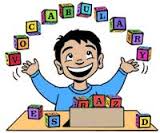 SAT Vocab Games Now On Get 800.com!
SAT Vocab Games Now On Get 800.com!

by Kazim Mirza
If you are a high school sophomore, junior, or senior, then you have probably started thinking about the SAT. The College Board (the organization that makes the exam) asserts that the SAT assesses literacy and writing skills needed for success in college. The College Board also administers the exam under a tight time limit, which tends to produce a wide range of scores. Even the brightest of students can feel the pressure of the time constraint, and may score in the “average” range. There are other criteria that colleges use for admissions including GPA, strength of course schedule, and extracurricular activities, but having a great SAT score can certainly increase your chances of getting in. How do you achieve an amazing score on that SAT?
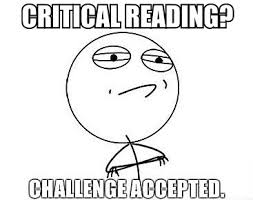 The first step is to know the exam. The Critical Reading section consists of three (3) parts: two (2) 25 minute sections and one (1) 20 minute section with questions types asking about long and short passages you’re asked to read, and sentence completion questions to test your vocabulary. Success on the Critical Reading section depends heavily on your ability to understand unfamiliar words in context. Your vocabulary skills are paramount to your success on over half of the exam, since the Writing section will also thoroughly assess your vocabulary skills. Therefore, the single most effective way to increase your score and ensure your great SAT score for college entrance is to increase your vocabulary. This can be done in many ways including: reading extensively, studying Latin and Greek roots, and taking challenging English courses in school.
The first step is to know the exam. The Critical Reading section consists of three (3) parts: two (2) 25 minute sections and one (1) 20 minute section with questions types asking about long and short passages you’re asked to read, and sentence completion questions to test your vocabulary. Success on the Critical Reading section depends heavily on your ability to understand unfamiliar words in context. Your vocabulary skills are paramount to your success on over half of the exam, since the Writing section will also thoroughly assess your vocabulary skills. Therefore, the single most effective way to increase your score and ensure your great SAT score for college entrance is to increase your vocabulary. This can be done in many ways including: reading extensively, studying Latin and Greek roots, and taking challenging English courses in school.
Another great way to increase your vocabulary is to play our SAT vocabulary games. SAT prep can be overwhelming, and the high pressure of the exam may be tremendous. Playing fun SAT vocabulary games can help you study for the exam in a much more amicable way. By playing games to help learn the SAT vocabulary words, you have a fun way to remember all the words, and you’ll have fun learning while your score goes up! Start Playing SAT Vocabulary Games Now!.
If you liked this article, please share it with your Facebook friends:
Best of luck with your SAT prep!
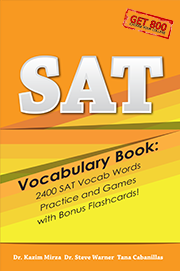 SAT Vocabulary Book
SAT Vocabulary Book

Today I would like to announce the new Get 800 SAT book: SAT Vocabulary Book: 2400 SAT Vocab Words, Practice, and Games, with Bonus Flashcards!
The paperback is now on sale on Amazon for only $5.03.
This sale may last for only a few hours, and once the sale ends the price will go up to $34.99. Amazon will automatically raise the price once a predetermined number of copies has been sold. If you want to take advantage of the sale price I strongly recommend you purchase the book now.
Click the following link to get to the book’s Amazon page: SAT Vocabulary Book
As an extra incentive to buy this book from Amazon I want to offer you an additional book for FREE as a downloadable PDF file. You can choose ANY book from the Get 800 collection. So if you would like a different book, go ahead and purchase this one (as soon as it is available), forward me your Amazon confirmation email and let me know which of my books you would like for free. You will be provided with a link to download your additional free book. This offer is available until October 20, 2014.
Take a look at my product page to see all of my books: Get 800 Product Page
You should also be aware that the following promotion is still available: if you buy any 2 of my books in paperback, you get all 6 of the following SAT math prep books for free.

A Trick For Free Two Day Shipping
Here is a little trick you can use to get free 2 day shipping on any of the books you decide to purchase without making any additional purchases. If you have never used Amazon Prime you can sign up for a free month using the following link.
Sign Up For Amazon Prime For Free
If you have already had a free trial of Amazon Prime you can simply open up a new Amazon account to get a new free trial. It just takes a few minutes! You will need to use a different email address than the one you usually use.
This next part is very important! After you finish your transaction, go to your Account, select “Manage my prime membership,” and turn off the recurring billing. This way in a month’s time Amazon will not start charging you for the service.
After shutting off the recurring billing you will still continue to receive the benefit of free 2 day shipping for one month. This means that as long as you use this new Amazon account for your purchases you can do all of your shopping on Amazon for the next month without having to worry about placing minimum orders to get free shipping.
Just be aware that certain products from outside sellers do not always qualify for free shipping, so please always check over your bill carefully before you check out.
Well I hope you decide to take advantage of this very special offer, or at the very least I hope you will benefit from my Amazon “free 2 day shipping trick.” Here is the link one more time:
Sign Up For Amazon Prime For Free
SAT Vocabulary Book – 2400 SAT words, SAT Vocab Practice and Games with Bonus Flash Cards
The SAT Vocabulary Book – 2400 SAT words, SAT Vocab Practice and Games with Bonus Flash Cards gives you the most effective method for building your SAT vocabulary. The SAT Vocabulary book is an essential part of every study plan to help you: get a perfect verbal score, improve your score to get into your dream school, and learn SAT Vocabulary in the fastest, most effective way possible. This book is unique because unlike other test prep books, we bring you the quickest and most effective method for doubling your vocabulary. We only focus on what you really need to learn, so you won’t waste your precious time. We know you have a busy schedule!
- breaking down words into their roots, prefixes, and suffixes. In fact, by studying our unique SAT Vocabulary Book, you will unlock your ability to double your vocabulary in a month! Most of these words are also used in medicine, law, engineering, and business, so what you learn now will also help you in your future!
- after learning the secret to increasing your vocabulary, the SAT Vocabulary Book then gives you plenty of practice questions and activities to work on, modeled exactly like actual SAT questions.
- you’ll learn some of the hardest SAT words through vocabulary games, so you’ll be prepared for Test Day. Plus, you get special bonus SAT flash cards for buying your copy today!
Thank you all for your continued support!
 SAT Vocabulary Book
SAT Vocabulary Book

Today I would like to announce the new Get 800 SAT book: SAT Vocabulary Book: 2400 SAT Vocab Words, Practice, and Games, with Bonus Flashcards!
This book will be released on Amazon within the next two weeks at a promotional price of about $5.40.
This sale may last for only a few hours, and once the sale ends the price will go up to $34.99. Amazon will automatically raise the price once a predetermined number of copies has been sold. If you want to take advantage of the sale price I strongly recommend that you get on the email notification list.
To be added to the notification list, simply send an email to steve@SATPrepGet800.com with “Notify me” written in the subject line.
In the meantime, you can take a look at my product page to see all of the other books from the Get 800 collection: Get 800 Product Page
If you think your friends might be interested in being notified of this special offer, please share it with them on Facebook:
Thank you all for your continued support!

 by Dr. Steve Warner
by Dr. Steve Warner

Hello everyone and welcome to my first educational book review. In my ongoing quest to help as many students as possible realize their full scholastic potential I am always looking for new teaching and learning methods. One of the biggest questions I am constantly thinking about is “why is it that some students seem to have very little trouble absorbing and retaining information, while for other students these tasks seem almost impossible?” More importantly, are there certain methods that a “smart” student is using that a struggling student can replicate to become “smarter?” Well author Scott Young seems to think so and he claims to teach these methods in his book “Learn more, study less.”
Click here to visit the website
As an educator I felt compelled to read through this book carefully with an open mind. Before I discuss some of the details about the book, I think that it is important that you understand how I would classify myself as a learner.
A bit about me
Throughout elementary school, high school, and college I never had any trouble learning. I would absorb and retain the information taught to me very quickly. I spent very little time outside of the classroom studying. I was always very “book smart.” Well at least until graduate school. When I began my graduate program in mathematics I struggled to understand the material for the very first time. There were huge gaps in my knowledge that needed to be filled, and my level of mathematical maturity was not high enough to be able to solve homework problems. But I worked extremely hard, and by my second year of graduate school I was no longer struggling and other students were coming to me for help.
If you asked me a week ago why I was always so smart in school, I would not have been able to give you a reasonable answer. If you asked me how I went from struggling in my first year of graduate school to becoming top of my class in the second year I would have given an incomplete answer at best. But now, after reading Scott Young’s book I believe that I can give a pretty clear explanation. During my time in school I have used almost every technique that Scott describes. At the time I never would have thought to describe what I was doing as “using techniques,” but I suspect that if I were to describe these methods to a “slow learner,” they would not be familiar with them, and might find them helpful.
Click here to visit the website
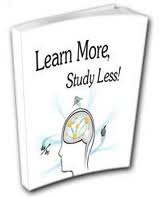 What is in the book?
What is in the book?

In “Learn more, study less,” Scott Young describes what he calls “holistic learning.” Holistic learning is essentially the opposite of rote memorization. The methods that he describes are very simple to understand. Some can be applied very quickly and others may require a concentrated effort on the part of the student.
An example of a simple technique described in the book is the link method. This is a good method to use when you are forced to memorize a sequence of arbitrary  information. This method involves creating vivid and exaggerated mental images that associate two symbols in the sequence. For example, we could link the entry “tiger” with the entry “tennis ball” by creating an image of a tiger standing upright juggling three tennis balls. This image is so ridiculous that it would be almost impossible to forget.
information. This method involves creating vivid and exaggerated mental images that associate two symbols in the sequence. For example, we could link the entry “tiger” with the entry “tennis ball” by creating an image of a tiger standing upright juggling three tennis balls. This image is so ridiculous that it would be almost impossible to forget.
An example of a more advanced technique is what Scott calls visceralization. This is similar to visualization, but allows for the possibility of involving sounds, sensations, and emotions in addition to simply imagining a mental picture.
Click here to visit the website
My thoughts on “Learn more, study less”
There is nothing that I have read in this book that I would consider “groundbreaking.” As I have said, once I read the book I realized that I have been using these techniques my whole life. I just never put a label on any of them. But I am really happy that I read it. I now have a way to describe, in simple terms, methods of studying that I believe can be effective for many students. When a student comes to me with retention issues, I now have a list of suggestions I can recommend to help them.
I think this is definitely a great book for educators to read. Academics that read this book will probably realize they have been using at least some of the techniques presented here their whole lives. After reading the book they will be able to describe these methods more easily to their students that are having retention issues.
Will the information in this book help students? Well I cannot answer this with 100% certainty since I have not tested it, but I am fairly confident that these techniques will work for some, if not many, students. If you are a student struggling to absorb and retain information, then I think that investing in this book would be a good decision. Try one or two of the techniques out for a month or two. I suspect that your scholastic performance will improve. If not, it was just a small time investment, and you can get your money back for the book (Scott Young has a four month return policy).
Click here to visit the website
Final Analysis
“Learn more, study less” is a really interesting book. Reading it has allowed me to name and describe some of the learning methods I have been using my whole life. I think that it is an especially good resource for educators. And for the struggling student I say “give it a try.” My gut feeling is that it will be extremely helpful for some students, and at the very least somewhat helpful for most students. Get the book, practice one or two of the methods that you connect with for a couple of months. My guess is that it will be a positive experience.
Final Score: 9/10
Click here to visit the website
Note: There is actually a full video course available as well. At this point in time I have only read the book, so I cannot give any feedback regarding the course.
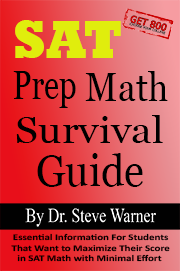 Extra Bonus
Extra Bonus
If you visit the “Learn more, study less” website using a link on this page, and then purchase either the book or video course, I will give you a free PDF of the “SAT Prep Math Survival Guide.” Simply forward your order confirmation email to steve@SATPrepGet800.com to receive your free bonus.
Click here to visit the website
Full Disclaimer: I have received no compensation for this review. Scott Young did provide me with all materials at no charge, but I have no personal interest in this product.
I spent several days reading this book carefully, and the opinions that I have shared about this book are all my own. I take great pride in providing accurate, useful, and honest information to my audience.
The links in this blog post are affiliate links. If you click on one of these links and decide to make a purchase I will receive a commission on the sale. This does not cost you anything additional. These small commissions help to keep the rest of the content on my blog free, so thank you!
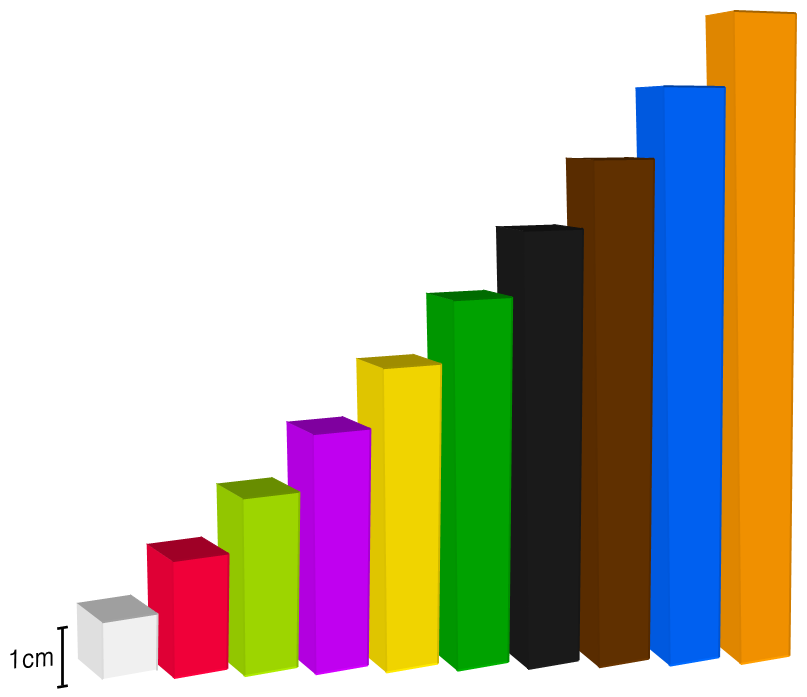
More Arithmetic Sequences

Welcome back. Today I would like to conclude our discussion on arithmetic sequences that we began two weeks ago. I recommend that you reread the first two posts on this topic before you move on to this one. Here are the links:
Arithmetic Sequences – Part One
Arithmetic Sequences – Part Two
Recall that an arithmetic sequence is a sequence of numbers such that the difference between consecutive terms is constant. The number d is called the common difference of the arithmetic sequence. In this post I would like to give a very formal method for solving problems involving arithmetic sequences. Note that it is not necessary to learn this material in order to answer these types of questions on the ACT or SAT, but every now and then the method given here gives a quicker way to solve a problem.
The arithmetic sequence formula
More advanced students may already know the arithmetic sequence formula:
In this formula an is the nth term of the sequence. For example, a1 is the first term of the sequence.
Example 1:
In the arithmetic sequence 20, 15, 10, 5, 0, -5, -10,… we have a1 = 20 and d = -5. Therefore we have
So for example, the 50th term of this arithmetic sequence is
Let’s revisit the second example from last week, but this time we will give a solution using the arithmetic sequence formula.
Example 2:
- Each term of a certain sequence is greater than the term before it. The difference between any two consecutive terms in the sequence is always the same number. If the fifth and ninth terms of the sequence are 33 and 97, respectively, what is the twelfth term?
Solution: Substituting 5 in for n and 33 in for an into the arithmetic sequence formula gives us
33 = a1 + 4d.
Similarly, substituting 9 in for n and 97 in for an into the arithmetic sequence formula gives us
97 = a1 + 8d.
So we solve the following system of equations to find d.
97 = a1 + 8d
33 = a1 + 4d
64 = 4d
The last equation comes from subtraction. We now divide each side of this last equation by 4 to get
d = 16.
Finally, we add 16 to 97 three times to get 97 + 16(3) = 145.
Note that this solution is definitely more tedious than the previous solution from last week’s post. I usually prefer identifying arithmetic sequences with linear equations.
More Problems Involving Arithmetic Sequences
If you are preparing for the ACT or an SAT math subject test, you may want to take a look at one of the following books:
If you liked this article, please share it with your Facebook friends:
And if you have any questions on this topic, then please post them in the Get 800 ACT/SAT prep forum:
I will answer your questions right away.
Speak to you soon!
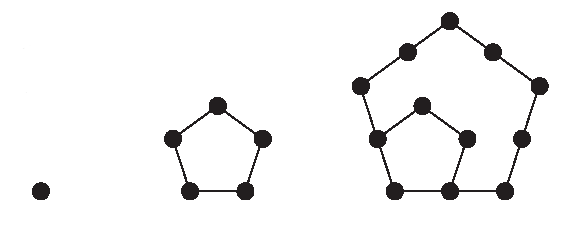 Arithmetic Sequences Continued
Arithmetic Sequences Continued

Hello again. Today I would like to continue our discussion on arithmetic sequences from last week. I recommend that you reread last week’s post before you move on to this one. Here is the link: Arithmetic Sequences
Recall from last week that an arithmetic sequence is a sequence of numbers such that the difference between consecutive terms is constant. The number d is called the common difference of the arithmetic sequence. In this post I would like to focus on the relationship between arithmetic sequences and linear equations.
Arithmetic sequences and linear equations
Recall the formula for the slope of a line:

There is a natural correspondence between arithmetic sequences and linear equations. Each term of an arithmetic sequence can be naturally identified with a point on the corresponding line. Let’s go back to our first example of an arithmetic sequence from last week:
Example 1:
1, 4, 7, 10, 13, 16,…
We can identify terms of the sequence with points on a line where the x-coordinate is the term number and the y-coordinate is the term itself.
(1,1), (2,4), (3,7), (4,10), (5,13), (6,16),…
These points all lie on the same line, and we can compute the slope of this line by using any two of these points. For example, let’s use the points (2,4) and (6,16).
We have
Do you recognize this number? That’s right! It’s the common difference of the sequence.
The identification of arithmetic sequences with linear equations gives us a nice method for finding the common difference of an arithmetic sequence as long as we know any 2 terms of the sequence.
Let’s try another example.
Example 2:
- Each term of a certain sequence is greater than the term before it. The difference between any two consecutive terms in the sequence is always the same number. If the fifth and ninth terms of the sequence are 33 and 97, respectively, what is the twelfth term?
Solution: We identify the two given terms with the points (5,33) and (9,97). The common difference is then
The twelfth term is then 97 + 16(3) = 145.
The information already covered in this post and the last is all you really need to know, but for completeness, next week I’m going to talk about the arithmetic sequence formula.
More Problems Involving Arithmetic Sequences
If you are preparing for the ACT or an SAT math subject test, you may want to take a look at one of the following books:
If you liked this article, please share it with your Facebook friends:
And if you have any questions on this topic, then please post them in the Get 800 ACT/SAT prep forum:
I will answer your questions right away.
Speak to you soon!
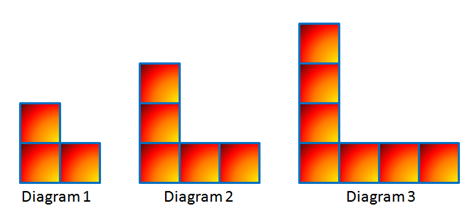 Arithmetic Sequences
Arithmetic Sequences

Hello everyone. Today I would like to talk about arithmetic sequences. Questions involving arithmetic sequences appear all the time on the ACT and SAT math subject tests, and once in a while on the SAT. Here is an example of an arithmetic sequence.
Example 1:
1, 4, 7, 10, 13, 16,…
Note that the first term of this sequence is 1, the second term of this sequence is 4, and so on.
So what makes this sequence arithmetic?
Well notice that to get from 1 to 4 we need to add 3. To get from 4 to 7 we also add 3. To get from 7 to 10 we also add 3. In other words, the sequence is arithmetic because we always add the same number to get from any term to the next term. This special number is called the common difference of the arithmetic sequence.
So why is this number called the common difference? Well another way to compute the common difference is to note that when we subtract any term from the next term we always get the same number, in this case that number is d = 3.
In other words we have 4 – 1 = 3, 7 – 4 = 3, and so on.
An arithmetic sequence is a sequence of numbers such that the difference between consecutive terms is constant. The number d is called the common difference of the arithmetic sequence.
Let’s try a simple example.
Example 2:
- The second term of an arithmetic sequence is 15 and the third term is 10. What is the first term?
Solution: Moving backwards, to get from the third term to the second term we add 5. Therefore we add 5 more to get to the first term. So the first term is
15 + 5 = 20.
This is choice E.
Note that in an arithmetic sequence, you always add (or subtract) the same number to get from one term to the next. This can be done by moving forwards or backwards through the sequence.
Note also that the common difference of this sequence is d = 10 – 15 = –5.
Many students might mistakenly say that the common difference is 5.
This particular problem was pretty simple, so we were able to solve it just by “counting.” In other words we didn’t really have to worry about the formalities of whether the common difference was positive or negative. But in harder questions we might need to be more careful.
Alternate solution: Note that the terms of the sequence are getting smaller so that the first term must be larger than 15. So the answer must be choice E.
In my next post we will learn a special technique that makes many seemingly difficult problems involving arithmetic sequences very easy to solve. So please check back next week.
More Practice with Arithmetic Sequences
If you are preparing for the ACT or an SAT math subject test, you may want to take a look at one of the following books:
If you liked this article, please share it with your Facebook friends:
And if you have any questions on this topic, then please post them in the Get 800 ACT/SAT prep forum:
I will answer your questions right away.
Speak to you soon!
Hello everyone.
Today I would like to go over the differences between the ACT and the SAT. I’ve already written a blog post on this subject here: The Differences Between the ACT and SAT
I have also just uploaded a video with this information to my YouTube channel. You can visit the YouTube page here: The Differences Between the ACT and SAT – Video
The video is also embedded below for your convenience:

